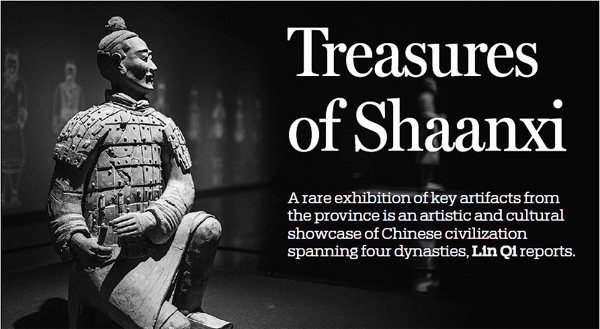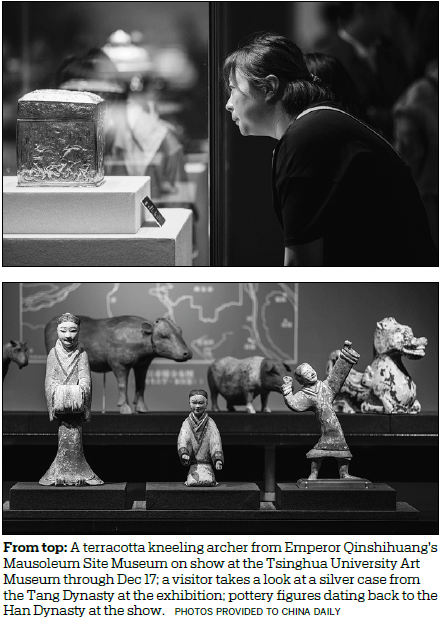Treasures of Shaanxi
A rare exhibition of key artifacts from the province is an artistic and cultural showcase of Chinese civilization spanning four dynasties, Lin Qi reports.
Ask any avid museumgoer to name the artifacts that epitomize the magnificence of Chinese civilization, and he or she may list famous objects like the 3,000-year-old bronze He Zun vessel, a kneeling terracotta archer guarding Qin Dynasty (221-206 BC) Emperor Qinshihuang in the afterlife, the gilt-bronze censers of the Western Han Dynasty (206 BC-AD 24), or even the painted three-colored glazed ceramics featuring horses and their riders from the Tang Dynasty (618-907).
They all represent a strong, influential era, and they all originated from today's Shaanxi province, which once enjoyed prominence in Chinese history.
People have seen these celebrated objects separately at museums, and are drawn to appreciate them again and again.
It is therefore something of a blockbuster claim when an exhibition can boast such a star-studded lineup to include all these artifacts of crucial significance to Chinese history and culture.
But the exhibition Everlasting Like the Heavens, an ongoing show at the Tsinghua University Art Museum through Dec 17, provides just that rare opportunity.
In collaboration with the Shaanxi Provincial Cultural Heritage Administration, the exhibition has been awing visitors with its collection of more than 300 objects drawn from prominent museums and archaeological institutions in Shaanxi, including the Shaanxi History Museum, Emperor Qinshihuang's Mausoleum Site Museum and the Baoji Bronzeware Museum.
It is a celebration of the culture and the arts of the Zhou (c. 11th century-256 BC), Qin, Han (206 BC-AD 220) and Tang dynasties, and to mark the 70th anniversary of the People's Republic of China this year.
Du Pengfei, deputy director of the Tsinghua University Art Museum, says Zhou, Qin, Han and Tang together constitute a long and historic era when China grew to become a major power and developed a diverse civilization that had an extensive influence around the world.
"Moreover, it was during this period of time that Shaanxi rose to be a stronghold of Chinese civilization, and for several centuries, the central region of the province, marked by cities such as Xi'an and Xianyang, became the political, economic and cultural center of China," he says.
"There was no better way than to bring together these cultural relics found in Shaanxi to represent the splendor and prosperity of the four featured dynasties and also the cultural and artistic heights that Chinese civilization reached at the time."
The exhibition will overwhelm viewers not just with the refinement of the objects on show, but also because of the sophisticated workmanship they embody. More importantly, it offers visitors an insight into how Chinese history and the core values of Chinese civilization advanced, according to Tan Shengguang, the exhibition curator.
"The ancient Chinese established order and traditions in accordance with the rules of nature and the universe, which formed the basis for Chinese civilization to develop through continual progress," he says.
The exhibition unfolds with the majestic momentum of early Chinese history with a display of ancient bronzeware, showing how the ruling classes of both the Shang (c.16th century-11th century BC) and Zhou dynasties set up rules of etiquette, while the increasingly intricate patterns and inscriptions on the bronze items not only reflect the power of their owners but also show what people of the time were thinking about.
The section dedicated to the Qin Dynasty, a strong but short-lived empire, shows the diversity of culture and thought, as well as the strength of its military and political system, which have been continuously enriched through archaeological findings.
The progression from the Han Dynasty to the Tang Dynasty takes the audience back in time where they are offered different angles to view how people lived, what they believed in and the arts they created a millennium ago.
The artifacts present a broad look at the world the Han aristocrats inhabited: works of pottery bear patterns reflecting people's daily lives, while the bronzeware reveal their emphasis on social status, and the gold and jade pieces evince their religious beliefs.
After the fall of the Han Dynasty came a long divided period of some three centuries, which led to a more extensive merging of cultures, lifestyles, social rituals and religions among the different ethnic groups, and eventually ushered in the glorious arrival of the Tang empire.
Contact the writer at linqi@chinadaily.com.cn


(China Daily Global 10/31/2019 page16)


















